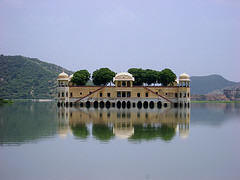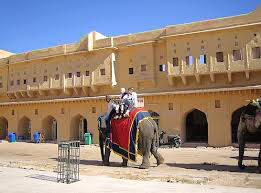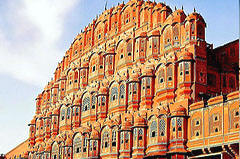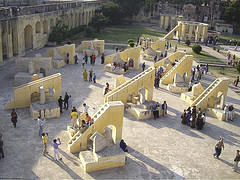|
Jaipur is one of the most popular
destinations on a tourist's itinerary. The magnificent forts,
beautiful havelis and colourful bazaars make Jaipur a popular
tourist destination among tourists. It's proximity to Agra, the
City of Taj, further adds to its appeal. Jaipur is part of the
famous Golden Triangle Tourist circuit that includes Delhi and
Agra. But Jaipur is not only endowed with wonderful tourist
attractions but the city also has an excellent infrastructure to
support the tourism. Jaipur has some of the India's best hotels,
which compliments the scenic and architecture beauty of the Pink
City.
Jaipur is the capita l
of Rajasthan, the desert state in India, which is famous for its
majestic forts, opulent havelis, beautiful lakes and sand dunes.
The history of Jaipur takes us about 300 years back in time, when
the Mughal empire in India was on the decline. At this time
Maharaja Sawai Jai Singh II in Rajasthan was looking for a safe
place to shift the increasing population of Amber and found Jaipur
to build the city. He commissioned Vidyadhar Bhattacharya, a fine
architect from Bengal the responsibility of building the city.
Jaipur was designed strictly according to Shilpa Shastra, which is
the ancient treatise on architecture. Thus Jaipur is considered as
the planned city in India. The city has been divided into nine
blocks and is encircled by a wall that has seven gates. l
of Rajasthan, the desert state in India, which is famous for its
majestic forts, opulent havelis, beautiful lakes and sand dunes.
The history of Jaipur takes us about 300 years back in time, when
the Mughal empire in India was on the decline. At this time
Maharaja Sawai Jai Singh II in Rajasthan was looking for a safe
place to shift the increasing population of Amber and found Jaipur
to build the city. He commissioned Vidyadhar Bhattacharya, a fine
architect from Bengal the responsibility of building the city.
Jaipur was designed strictly according to Shilpa Shastra, which is
the ancient treatise on architecture. Thus Jaipur is considered as
the planned city in India. The city has been divided into nine
blocks and is encircled by a wall that has seven gates.
Jaipur is also known as the Pink City. Jaipur's date with the pink
color goes back to 1905-06, when Jaipur city was getting ready to
welcome the Prince of Wales and needed a fresh coat of paint. But
the contractor's inability to provide any other color except the
pink saw Jaipur washed in pink hue. Since then Jaipur is known as
the Pink City.
Today Jaipur is a thriving tourist destination, which attracts a
number of tourists every year. Forts and palaces are what attract
most tourists to Jaipur. There are a number of forts and palaces
in and around Jaipur that tell the tales of Jaipur's rich and
vibrant heritage. Some of the important landmarks in and around
Jaipur include the Amber Fort, Hawa Mahal, Jantar Mantar
observatory, Jaigarh Fort, Gaitore, and Nahargarh Fort.
Jaipur History
The history of the Pink City of Jaipur dates back to the 18th
century, during the reign of Maharaja Sawai Jai Singh II. It was
after it became difficult to accommodate the increasing population
at Amber (which is about 11 kilometres from Jaipur), Sawai Jai
Singh was in search of safe and secure place to built a new city.
The paucity of water at Amber further aggravated the problem of
increasing population.
It was in 1727, Swai Jai Singh with his architect Vidyadhar
Bhattacharya founded the Jaipur city. The city was built adhering
to the principles of Shilpa Shastra and thus become the first
planned city of India. The city follows grid system with wide
straight roads, streets and lanes. One can find uniform rows of
shops on either side of main roads. As a security measure from
external aggression, the city was en-circled with a strong wall
with seven gates.
Jaipur is still one of the beautiful cities in India with most of
its forts and palaces perfectly in shape. Forts and palaces in and
around Jaipur are what attract tourists to the Pink City. Jaipur
has a number of fine hotels that provide best hospitality service
to guests touring Jaipur.
Jaipur Sightseeing
Amber Fort
Amber is located at a distance of 11 kilometers from Jaipur and
was the old fort of the Kachhwaha clan of Amber, which used to be
the ca pital,
till it was moved to Jaipur. pital,
till it was moved to Jaipur.
The construction of the Amber Fort began in the year 1592 and was
started by Man Singh I, but it was finished by his descendant Jai
Singh I. The exterior of the Fort is not in the least like its
interiors. The outside is very imposing and rugged looking whereas
the inside is a comforting and warm interior which is influenced
by both Hindu and Muslim style of ornamentation. On the walls, are
paintings depicting various hunting scenes, and there is also a
lot of work on walls, which are covered with intricate carving,
mosaic and minute mirror work that make the halls look very
majestic and imperial. The fort is built with white marble and red
sandstone and look even more attractive because of the Maota Lake
in the foreground. The fort in itself is a beautiful sight to
behold but as one looks on the fort with its clear reflection on
the lake in the front, one cannot help but wonder if it is a dream
or a beautiful illusion.
Amber Fort also called the Amer Fort is a must-see if you are
visiting Rajasthan. The tourists to this fort can either approach
the fort by road or take an elephant ride, which though is quite
slow yet is a lot of fun.
If you are in Rajasthan, do not miss the opportunity to tour the
Amer Fort, which is one of the important forts of the city and one
of the major attractions of Jaipur.
Hawa Mahal
The Hawa Mahal, which adjoins the famous City Palace wall, was
built in 1799 by Maharaja Sawai Pratap Singh and has now become
one of the
 major
landmarks of Jaipur. The palace is shaped like a pyramid and is a
five-storied building, with number of small windows and screens,
with arched roofs. As one looks at this building, one realizes
that the rear side of the building is comparatively very plain and
lacks much of ornamentation. One is rather surprised at the
contrast, since in the front there is intricate carving and much
attention has been paid to even minute details yet the backside is
more a mass of pillars and passages. major
landmarks of Jaipur. The palace is shaped like a pyramid and is a
five-storied building, with number of small windows and screens,
with arched roofs. As one looks at this building, one realizes
that the rear side of the building is comparatively very plain and
lacks much of ornamentation. One is rather surprised at the
contrast, since in the front there is intricate carving and much
attention has been paid to even minute details yet the backside is
more a mass of pillars and passages.
Since the Hawa Mahal was built at a time when women of the royal
families had to observe strict purdah, many believe that the Hawa
Mahal was built, just so these ladies could watch the processions
and various activities taking place on the streets. This does
explain why Hawa Mahal has such tiny windows and many screened
balconies. The royal ladies could look below at the people without
showing themselves and thus enjoy a sense of freedom.
The Hawa Mahal is a great example of the Rajputana architecture,
which was strongly influenced by Mughal style of architecture.
This particular style of building that we observe in Hawa Mahal,
uses the best features of Mughal architecture with other features
that could better adapt to the inhospitable weather conditions of
Rajasthan.
Jantar Mantar
The Jantar mantar in Jaipur is th e
most famous one among the five observatories built by Sawai Jai
Singh and is located close to the gate of the famous City Palace
of Jaipur. So when you are in Jaipur, do not miss the opportunity
to check out the biggest stone observatory in the world, which is
still in a running condition and stands witness to the wisdom of
the former age. e
most famous one among the five observatories built by Sawai Jai
Singh and is located close to the gate of the famous City Palace
of Jaipur. So when you are in Jaipur, do not miss the opportunity
to check out the biggest stone observatory in the world, which is
still in a running condition and stands witness to the wisdom of
the former age.
Maharaja Sawai Jai Singh II, the Rajput ruler of Amber and the
founder of Jaipur was a learned man and an astronomer who was
deeply interested in the workings of the celestial bodies and so
built the Observatory, known as Jantar Mantar. The name 'Jantar
Mantar' comes from Sanskrit's 'Yantra Mantra' meaning instruments
and formulae.
Sawai Jai Singh II was commissioned by Emperor Muhammad Shah, to
make corrections in the astronomical tables and to confirm the
data, already available on the planetary positions. Sawai Jai
Singh II took seven years to finish the task. He built the first
stone observatory in 1724 in Delhi. The Jaipur observatory was
built in 1728. There is actually a fascinating story in relation
to the construction of the Observatory. According to the story,
Sawai Jai Singh II sent his envoys to various parts of the world.
The emissaries came back with manuals and astronomical tables
besides tons of data on the advances made in the fields of
astronomy. La Hire's "Tables" was one of these manuals, and
impressed by it, Sawai Jai Sing II ordered the observatory to be
constructed according to the data available in this manual.
Amazingly, after Jantar Mantar was built, it was discovered that
the Observatory was more accurate than the Table itself.
City Palace
The City Palace was built by Maharaja Jai Singh II of the
Kachhwaha clan of Rajputs, but a lot of changes and additions were
made to the original structure by his successors.
The architecture of the City Palace is a synthesis of Rajasthani
and Mughal styles. The Complex comprises of many structures,
courtyards, gardens and buildings. There are many splendid small
palaces and halls in the complex, such as the Chandra Mahal,
Mubarak Mahal and Badal Mahal. There is also a famous temple
called the Shri Govind Temple and a museum inside, named the City
Palace Museum.
Laxmi Narayan Temple
The Laxmi Narayan is located in the South of Jaipur, and was built
by the Birla family, which is a major industrialist family of
India. This is why, the temple is also called the 'Birla Mandir'.
It is situated quite close to the Moti Doongri fort, which was
converted to a small palace by Ram Singh II and Gayatri Devi.
Keeping in mind the secular nature of the country, the temple has
three domes, which represent different approaches to religion. It
is a beautiful white marble temple, which seems to glow at night.
The Birla Mandir in Jaipur attracts many tourists and devotees
every year. The temple is very crowded during the festivals as
Hindus come from all over the state and country to pay their
respect to the Lord. Next time you have a holiday, come to Jaipur
and visit the Birla Mandir, dedicated to Lord Vishnu and Goddess
Laxmi
How to Reach
By Air : One can take a flight from any of the major cities across
India to reach Jaipur. The Pink City is very well connected by air
to Delhi and Mumbai. The airport is about 15 kilometres from the
Pink City and it takes about 25 minutes to reach the city.
By Rail Indian Railways connects Jaipur with other cities of India
with a number of trains. From Delhi the Pink City express connects
Jaipur, the train leaves Delhi at 6 in the morning and reaches
Jaipur at 11 am. There are a number of other trains that connects
Jaipur from different parts of India.
By Road Jaipur is well connected by road to major towns in India. |